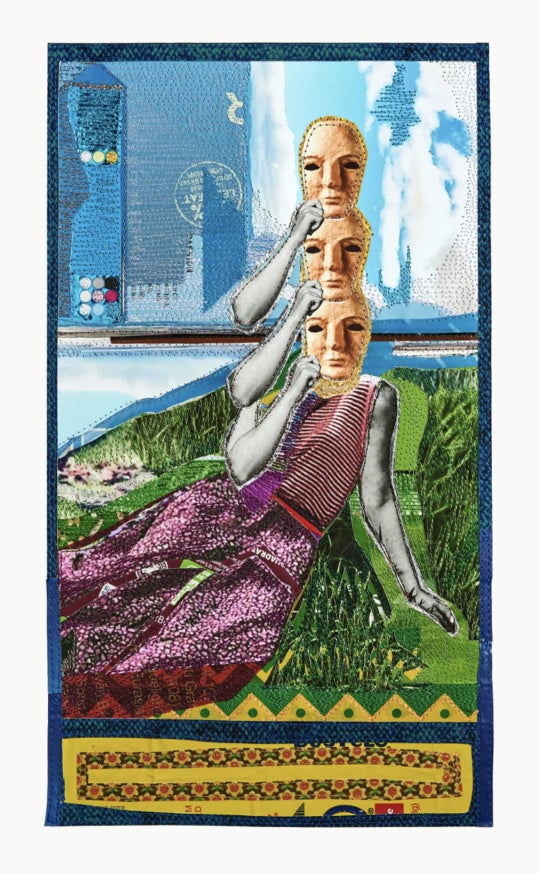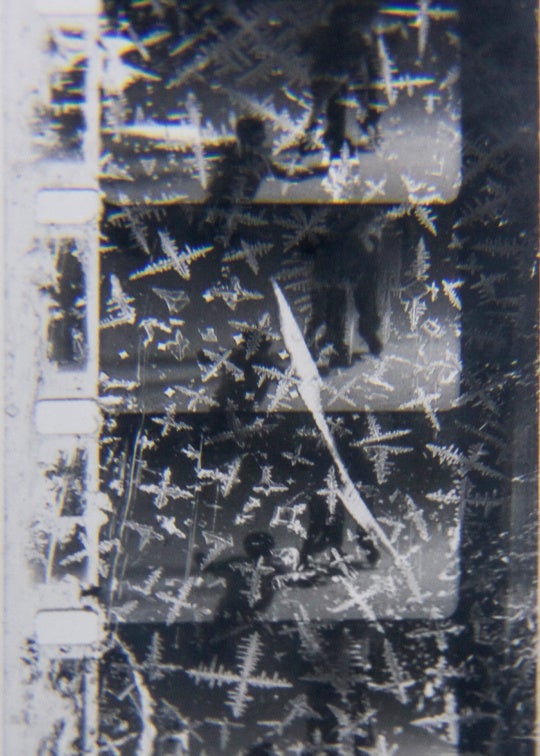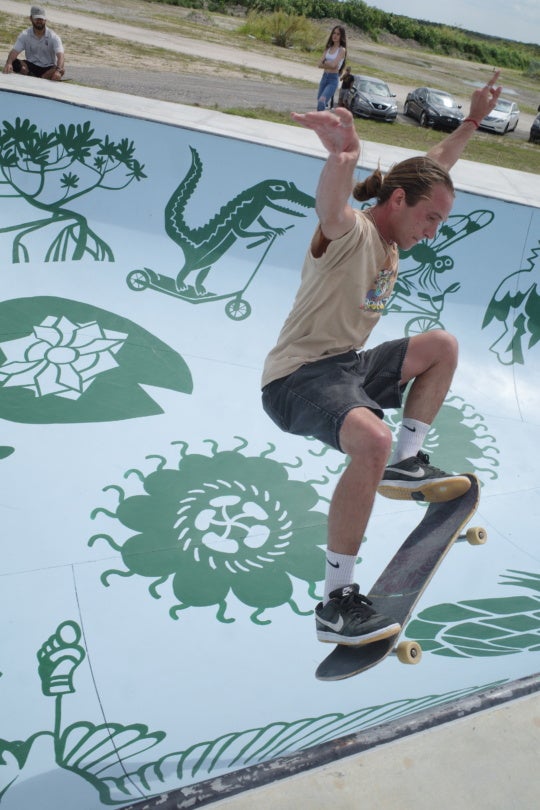
Discrete Aperture: The Work of Nils Folke Anderson recently closed in the Circle Gallery of the newly-renovated UGA Jackson Street Building—now home to the College of Environment + Design [January 17-February 14, 2013]. Anderson presented a group of eight works—including paintings, a light sculpture, and three installations created on-site—specifically for the exhibition. The show also featured an interactive work, titled Haptic Geometry (2013), in which the public was invited to participate in configuring a group of “reciprocally linked” sculptures.
The Georgia Museum of Art recently acquired two of Anderson’s sculptures from the exhibition for their collection. Below are excerpts from a conversation between Anderson, Lynn E. Boland, Pierre Daura Curator of European Art at the Georgia Museum of Art, and myself, curator of the Discrete Aperture show and Assistant Professor of the UGA College of Environment + Design.
Stephen J. Ramos: Nils, I’d like to start by asking your thoughts on how your work addresses engagement between art and design, which was central for the show’s conception.
Nils Folke Anderson: To begin, we chose to show art in a gallery whose primary audience would be the students of the College of Environment + Design, and in a building that until quite recently housed the Lamar Dodd School of Art. Underlying this decision was a desire to create an interdisciplinary dialogue that reaffirms, rather than blurs, the distinctions between disciplines.
What creative levers can we find in other fields—formally, conceptually, et cetera—to shed familiar modes of work and open up new spaces of exploration and practice? This question is enriched by the proposition that there are differences, even antipathies, between disciplines, and our choice of context was the starting point.
Steve, when you came up with the title Discrete Aperture it immediately resonated for me on many levels, and one was in the sense of the interdisciplinary: There is a sense of freedom that can result from asserting the discreteness and difference between fields of activity and operating in that space. Can you speak about the concept of discrete aperture and about how it relates to the exhibition?

SJR: In your work you’ve created a framework where you allow yourself limitless formal possibility within a bounded language. It conveys both introspection and overture, as an open system where form is not lost in dynamism. That language helps to explore infrastructure, from surface ground, as with the floor piece—Gun Tiles, 2013—to the monumental forms around which the show is organized. It’s both a challenge and a way forward, and it’s inspiring across fields. For me, this was the genesis for the collaboration, which we’ve been discussing for a long time.
Related to what you’d mentioned, the collaboration itself is a measured overture, or aperture, among our respective disciplines. The disciplinary integrity doesn’t dissolve, but there is desire to be challenged through new perspectives and understandings.
The two large pieces [Stretch by 2, recline to center, x 9 and Stretch by 3, recline to center, x 5, both 2013] each introduce facades into the reciprocal linkage language that you’d developed, and I think of this as a kind of new aperture. They seem to be breaches of the linkage autonomy. It’s very exciting that you are debuting these pieces, along with the floor piece [Gun Tiles, 2013] for the show. Can you speak about the new pieces in relation to the other works?

NFA: The two large wall pieces evolved from earlier explorations in Styrofoam of a formal principle that I describe as ‘reciprocal linkage.’ In reciprocal linkage, a number of frame-like elements are linked together so that each element links through every other element. All of these elements are constructed exactly alike, and each has the same relationship to the whole as any other.
The planes defined by the elements have a suggested volume, and I began considering reciprocal linkage as part of a larger progression, in which the planes could go through a change of state, becoming solid planes rather than framed spaces. Once those two states are established—solid volume planes and framed (or empty) volume planes—many other possibilities begin to emerge, such as extruded solid planes, or pivoting planes, and these in turn can exist in a continuum with reciprocal linkage to create more complex forms.
The end result in this show were sculptures that included wall-like forms, balanced and supported by the interdependency of the reciprocally-linked elements in which the sculptures terminate/begin. Sculpture can offer a sense of the malleability of space and materials—our basic agency as dwellers and builders in the world—and my interest with these pieces was to invest walls with this sense of possibility and movement.

SJR: When I was photographing the installation shots, a woman enjoying the show told me that the sculptures made her want to jump into them and start dancing. It turns out she had trained with Merce Cunningham and was with him during his collaborations with Rauschenberg. We’ve talked about that collaboration as a reference, so it was a nice cosmic visit. It certainly affirms the transmission of possibility, movement, and joy in the work. And, again, overture to the viewer as participant.
NFA: That’s a beautiful story. I fortunately spent time with Merce Cunningham over the last couple of years before he passed away, and was invited to create a décor proposal. Unfortunately, the set was unrealized, but meeting Merce and seeing the company rehearse and perform was a huge inspiration.
Generally, the concept of chance operations as employed by Merce Cunningham and John Cage has been a major influence, as has the exploration of the “open work” in the writing of Umberto Eco, or for example in Lygia Clark’s series Bichos.
Lynn E. Boland: I’m fascinated to learn of the Cunningham connection. That resonates with some of my first thoughts upon seeing Anderson’s exhibition at the Circle Gallery. As a curator of European art, it’s probably not surprising that the first lens through which I viewed the work was a historical one.
I’ve been engaged in work on a few different shows lately that all seem to start with the year 1968 in one way or another, involving Sol LeWitt, Carl Andre, Dan Flavin, Keith Sonnier, and others of that ilk. I really fell in love with the way that Anderson’s work seems informed by these sculptors while undeniably being a product of the 21st century.
For instance, I don’t think I’m alone in recognizing at least a superficial resemblance to many of LeWitt’s sculptures in the reciprocal links and especially in the large Styrofoam pieces [Stretch by 2, recline to center, x 9 and Stretch by 3, recline to center, x 5, both 2013] and, more important, in the relationship of solid volume and framed, negative space. Where LeWitt’s work was both deductive and reductive, Anderson opens up these issues. I always hesitate to address contemporary work in this way, but I can’t help but think of them as LeWitts for the Internet age.
Similarly, the floor piece [Gun Tiles, 2013] engages issues addressed by Andre’s floor works, but Anderson adds new levels of viewer interactivity and interrelationships between formal elements within the work. These connections make his work especially exciting for a teaching museum like the Georgia Museum of Art.
SJR: Nils, can you talk about your invitation for viewers to interact with the Haptic Geometry piece?
NFA: Haptic Geometry marked the first time I made my work available for interaction in the context of an exhibition, and it draws on the modalities mentioned above—chance operations and the open work. In configuring reciprocally linked works, touch precedes sight. Only when the linked elements come to a stable resting point does it become possible to fully see the configuration. I wanted to offer that experience in the context of the larger works.
Touch is key here—we often comprehend geometry in visual and conceptual terms, but we are also constantly experiencing geometric form—particularly in built spaces—as a tactile reality, whether as planar surfaces like walls and floors, or the roundness of a handrail, the square-ness of a book, etc. With Haptic Geometry, my hope was to engage this physical intelligence we carry inately just from being in the world, and to present that as a point of access to the other work.
The experience of playing with these sculptures is also challenging. Reciprocal linkage creates a situation of partial control, introducing effort, frustration and humor. This is a point of distinction from chance operations, which adopt an external mechanism to create distance between the will of the artist and the work. Here that distance is an internal matter, and the choice of stopping point is the fulcrum upon which the significance of the interaction is established.
SJR: That’s beautifully articulated. The tactile, material experience of Haptic Geometry becomes the experiential threshold for the viewer into the rest of the work and its suggested abstractions—an aperture into the larger linkage.

NFA: And a tangible immersion into the kind of complex interdependencies that characterize our time, which can emerge from the simplest forms. In the early work of Carl Andre and Sol LeWitt, the repetition of squares offered a means to reduce, regularize and clarify internal relationships within artworks. But repetition contains a paradox: In a given repetition of forms, each form occupies a unique position in relation to the whole. Sherrie Levine’s re-photographing of Walker Evans’ work explored this paradox to powerful effect. Sometimes the seemingly basic act of repetition can be explosive. From a purely relativistic point of view, repetition is impossible.
In this regard, reciprocal linkage has two simultaneous realities. As I mentioned, each element is constructed exactly alike to all the others, and in fact has the same relationship to all the others because any given element can exchange position with any other element. This is true in so far as it is considered a dynamic entity, always in flux. And, unlike a nine square grid, for example, a given element can change place with any another element without ever disrupting the basic formal organization.
The closest we can come to this in a nine square grid is by leaving one space empty, like those toys with the sliding squares, which allow any square to be positioned in any of the nine spaces. On the other hand, in any given moment or configuration of a reciprocal link, each element is completely differentiated from the others by its relative position, which can result in very complex structures occurring in three dimensional space.
It all begins with an empty frame, a discrete aperture.
For further viewing: A documentary with Nils Folke Anderson on the making of his exhibition as well as a time-lapse video of the installation are available, both by Russell Oliver.
Nils Folke Anderson (b. Washington, DC) is a painter and sculptor based in Brooklyn, NY. His work has been exhibited widely, including showsat Phillips De Pury, NYC, the Dikeou Collection, Denver, CO, Robert Miller Gallery, NYC, and The Bemis Center for Contemporary Art, Omaha, NE. His sculpture Pioneers Gate, a permanent public work, was recently installed in Ilford, UK. Anderson’s work has been reviewed in many publications, including the New York Times, the New Yorker, Artnet, ArtPress, ARTnews, and The Economist’s culture blog, More Intelligent Life. The work of Nils Folke Anderson is in numerous public and private collections, including UBS, NASA, the BakerIE, and the Collection of Jean Pigozzi.
Stephen J. Ramos is an Assistant Professor in the College of Environment and Design at the University of Georgia. He is author of Dubai Amplified: The Engineering of a Port Geography (Ashgate Press: 2010), and co-editor of Infrastructure Sustainability and Design (Routledge: 2012). He is a founding editor of the New Geographies journal, and editor-in-chief of New Geographies Volume 1: After Zero (Harvard GSD and University Press: 2009). His writing has appeared in the Harvard Design Magazine, Volume, and Neutra.
Lynn E. Boland has served as Pierre Daura Curator of European Art at the Georgia Museum of Art since 2009. He is currently completing his doctorate in art history from the University of Texas at Austin, where he received his master’s degree. Boland received his undergraduate degree in art history from the University of Georgia. He specializes in European art history of the 19th and 20th centuries with a secondary focus in contemporary American art. Some of Boland’s recent exhibitions include Water Music, The New York Collection for Stockholm, De Wain Valentine: Human Scale, and Francisco de Goya’s “Disasters of War,” with a major exhibition, Cercle et Carré and the International Spirit of Abstract Art, opening this fall.




